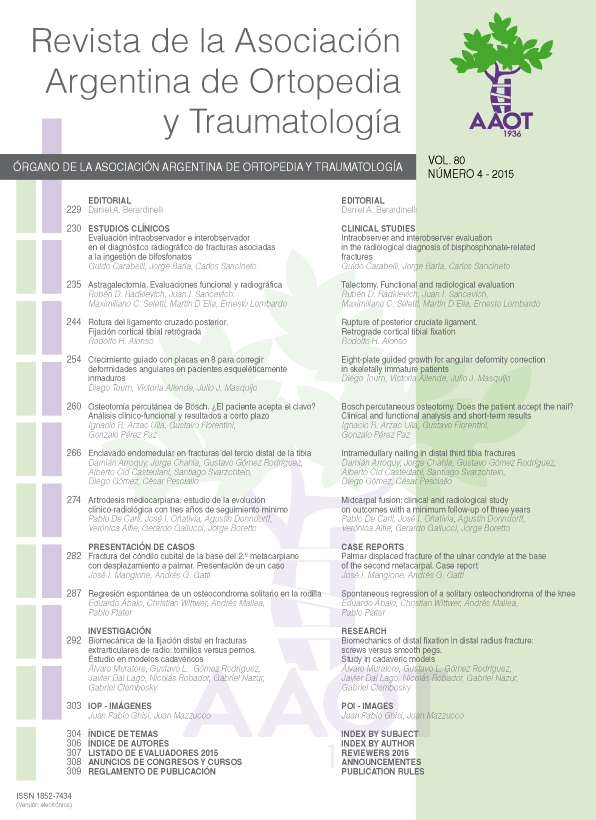Intramedullary nailing in distal tibial fracture
Main Article Content
Abstract
Downloads
Metrics
Article Details

This work is licensed under a Creative Commons Attribution-NonCommercial-ShareAlike 4.0 International License.
Manuscript acceptance by the Journal implies the simultaneous non-submission to any other journal or publishing house. The RAAOT is under the Licencia Creative Commnos Atribución-NoComercial-Compartir Obras Derivadas Igual 4.0 Internacional (CC-BY-NC.SA 4.0) (http://creativecommons.org/licences/by-nc-sa/4.0/deed.es). Articles can be shared, copied, distributed, modified, altered, transformed into a derivative work, executed and publicly communicated, provided a) the authors and the original publication (Journal, Publisher and URL) are mentioned, b) they are not used for commercial purposes, c) the same terms of the license are maintained.
In the event that the manuscript is approved for its next publication, the authors retain the copyright and will assign to the journal the rights of publication, edition, reproduction, distribution, exhibition and communication at a national and international level in the different databases. data, repositories and portals.
It is hereby stated that the mentioned manuscript has not been published and that it is not being printed in any other national or foreign journal.
The authors hereby accept the necessary modifications, suggested by the reviewers, in order to adapt the manuscript to the style and publication rules of this Journal.
References
2. Lee YS, Chen SW, Chen SH, Chen WC, Lau MJ, Hsu TL. Stabilisation of the fractured fibula plays an important role in the treatment of pilon fractures: a retrospective comparison of fibular fixation methods. Int Orthop 2008;33: 695-9.
3. Bucholz RW, Heckman JD, Court-Brown C (eds.) Rockwood & Green’s: Fractures in Adults, 6th ed. Philadelphia: Lippincot Williams & Wilkins; 2006.
4. Topliss CJ, Jackson M, Atkins RM. Anatomy of pilon fractures of the distal tibia. J Bone Joint Surg Br 2005;87:692-7.
5. Blachut PA, O’Brien PJ, Meek RN, Broekhuyse HM. Interlocking intramedullary nailing with and without reaming treatment of closed fractures of the tibial shaft. A prospective, randomized study. J Bone Joint Surg Am 1997;79:640-6.
6. Collinge C, Kuper M, Larson K, Protzman R. Minimally invasive plating of high-energy metaphysial distal tibia fractures. J Orthop Trauma 2007;21:355-61.
7. Nork SE, Shwartz AK, Agel J, Holt SK, Schrick JL, Winquist RA.
Intramedullary nailing of distal metaphyseal tibial fractures. J Bone Joint Surg Am 2005;87:1213-21.
8. Sarmiento A, Sharpe FE, Ebramzadeh E, Normand P, Shankwiler J. Factors influencing the outcome of closed tibial fractures treated with functional bracing. Clin Orthop Relat Res 1995;315:8-24.
9. Sheerin DV, Turen CH, Nascone JW. Reconstruction of distal tibia fractures using a posterolateral approach and a blade plate. J Orthop Trauma 2006;20:247-52.
10. Gustilo RB, Anderson JT. Prevention of infection in the treatment of one thousand and twenty-five open fractures of long bones: retrospective and prospective analyses. J Bone Joint Surg Am 1976;58:453-8.
11. Kitaoka HB, Alexander IJ, Adelaar RS, Nunly JA, Myerson MS, Sanders M. Clinical rating systems for the ankle, hind foot, mid foot, hallux and lesser toes. Foot Ankle Int 1994;15:349-53.
12. Court-Brown CM, MC Birnie J. The epidemiology of tibia fractures. J Bone Joint Surg Br 1995;77:417-21.
13. White RR, Babikian GM. Tibia shaft. En: Ruedi TP, Murphy WM (eds.) AO Principles of Fracture Management. Stuttgard: Thieme; 2000:519-36.
14. Yaligod V, Rudrappa GH, Nagendra S, Shivanna UM. Minimizing the complications of intramedullary nailing for distal third tibial shaft and metaphyseal fractures. J Orthop 2013;11(1):10-8.
15. Janssen KW, Biert J, Kampen A. Treatment of distal tibial fractures: plate versus nail. A retrospective outcome analysis of matched pairs of patients. Int Orthop 2007;31:709-14.
16. Ruedi T, Allgower M. Fractures of the lower end of the tibia into the ankle joint. Injury 1969;1:92-9.
17. Buzzi R, Bertini A, Cecchi F, Giron F. Distal tibial-fibular fractures: treatment with fibular fixation and locked intramedullary nailing. J Orthop 2009;1:33-40.
18. Kumar A, Charlebois SJ, Cain EL, Smith RA, Daniels AU, Crate JM. Effect of fibular plate fixation on rotational stability of simulated distal tibial fractures treated with intramedullary nailing. J Bone Joint Surg Am 2003;85:604-8.
19. Teitz CC, Carter DR, Frankel VH. Problems associated with tibial fractures with intact fibulae. J Bone Joint Surg Am 1980;62:770-6.
20. Rouhani A, Elmi A, Akbari Aghdam H, Panahi F, Dokht Ghafari Y. The role of fibular fixation in the treatment of tibia diaphysis distal third fractures. Orthop Traumatol Surg Res 2012; 98:868-72.
21. Whittle AP. Campbell’s Operative Orthopaedics, 11th ed., Philadelphia: Mosby; 2008; vol. 3, p. 3122.

